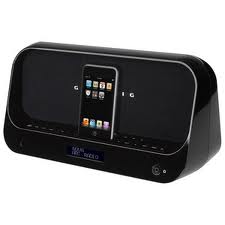“Digital Radio prices have come down to as low as $49,” Joan Warner told the Radcomms Conference in Sydney today. Reviewing the roll out of digital radio so far, Warner revealed that 824,000 people are now listening to digital radio, more than are listening to internet streaming. Warner suggested that digital radio sales are probably higher than the “conservative estimate” of 457,000 measured by the official figures. Those figures do not take into account iPod docks and other devices which also have digital radio receivers included in them, such as the Grundig iPod dock (pictured), which also includes a digital radio.
Time spent listening to digital radio is now up to 10 hours 4 minutes per week, compared with analog listening, which is still of course much higher at 19 hours 21 minutes, but ahead of internet at 5 hours 16 minutes.
Coverage is also a key priority for the industry, according to Warner, who said “there is not much point in having great content if people can’t hear it.” The Australian radio industry has developed world leading on-channel repeater technology to fill black spots. The on-channel repeater has been trialed in Melbourne from a building at 101 Collins Street and has successfully filled the digital radio black spots in the Melbourne CBD. Now that the trial has worked CRA intends to convert the test licence into a full time licence for this service, then to roll out the repeater procedure where needed in other capitals.
CRA has been able to identify black spot areas from listener comments about reception, an indication that people are hearing the messages to buy digital radios and actively listening to the new signals.
Warner said consumer research has revealed that people who buy one digital radio often come back within a short time frame and buy one or two more once the realize the benefits of going digital.
In regional areas commercial stations “are of the opinion that they may need to share transmission facilities with the public broadcasters ABC and SBS,” Warner told the audience, although she acknowledged that the public broadcasters do not necessarily agree with this viewpoint at this time.

